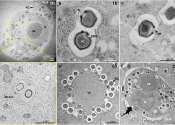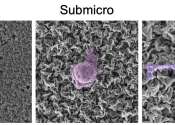Study suggests that cells possess a hidden communication system
Cells constantly navigate a dynamic environment, facing ever-changing conditions and challenges. But how do cells swiftly adapt to these environmental fluctuations?

Cells constantly navigate a dynamic environment, facing ever-changing conditions and challenges. But how do cells swiftly adapt to these environmental fluctuations?
Cell & Microbiology
20 hours ago
0
109

Transparent solar cells will transform the look of infrastructure by enabling many more surfaces to become solar panels. Now, materials called non-fullerene acceptors that can intrinsically generate charges when exposed to ...
Condensed Matter
21 hours ago
0
29

LMU researchers have developed a method to determine how reliably target proteins can be labeled using super-resolution fluorescence microscopy.
Molecular & Computational biology
22 hours ago
0
22

The single-celled organism Naegleria fowleri ranks among the deadliest human parasites. Researchers around Matthias Horn and Patrick Arthofer from the Center for Microbiology and Environmental Systems Science at the University ...
Cell & Microbiology
23 hours ago
0
16

Medical implants could fail less often when coated with a microscopically crinkled, ceramic material designed by researchers at the University of Michigan. The coating is described in a paper published in ACS Applied Materials ...
Nanomaterials
23 hours ago
0
2

Cells buzz with millions of different biomolecules that diffuse chaotically through their substructures, yet they manage to ensure exquisite functional and spatial specificity.
Cell & Microbiology
23 hours ago
0
11

The beginning of life is shrouded in mystery. While the intricate dynamics of mitosis are well-studied in the so-called somatic cells—the cells that have a specialized function, like skin and muscle cells—they remain ...
Cell & Microbiology
Apr 24, 2024
0
16

A group of researchers have expanded conventional knowledge on a critical enzyme that controls cell migration. In a publication in the journal Nature Communications, they reported that phosphoinositide 3-kinase (PI3K) not ...
Cell & Microbiology
Apr 24, 2024
0
32

Imagine being able to look inside a single cancer cell and see how it communicates with its neighbors. Scientists are celebrating a new technique that lets them study the fatty contents of cancer cells, one by one.
Biochemistry
Apr 23, 2024
0
63

In a new study published in Nature Chemistry, UNC-Chapel Hill researcher Ronit Freeman and her colleagues describe the steps they took to manipulate DNA and proteins—essential building blocks of life—to create cells that ...
Biochemistry
Apr 23, 2024
0
101
The cell is the structural and functional unit of all known living organisms. It is the smallest unit of an organism that is classified as living, and is often called the building block of life. Some organisms, such as most bacteria, are unicellular (consist of a single cell). Other organisms, such as humans, are multicellular. (Humans have an estimated 100 trillion or 1014 cells; a typical cell size is 10 µm; a typical cell mass is 1 nanogram.) The largest known cell is an unfertilized ostrich egg cell.
In 1835 before the final cell theory was developed, a Czech Jan Evangelista Purkyně observed small "granules" while looking at the plant tissue through a microscope. The cell theory, first developed in 1839 by Matthias Jakob Schleiden and Theodor Schwann, states that all organisms are composed of one or more cells. All cells come from preexisting cells. Vital functions of an organism occur within cells, and all cells contain the hereditary information necessary for regulating cell functions and for transmitting information to the next generation of cells.
The word cell comes from the Latin cellula, meaning, a small room. The descriptive name for the smallest living biological structure was chosen by Robert Hooke in a book he published in 1665 when he compared the cork cells he saw through his microscope to the small rooms monks lived in.
This text uses material from Wikipedia, licensed under CC BY-SA